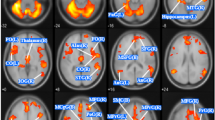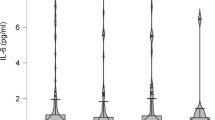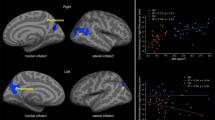Abstract
Anorexia nervosa (AN) is characterized by extremely low body weight resulting from pathological food restriction, and carries a mortality rate among the highest of any psychiatric illness. AN, particularly during the acute, underweight state of the illness, has been associated with abnormalities across a range of brain regions, including the frontal cortex and basal ganglia. Few studies of AN have investigated the thalamus, a key mediator of information flow through frontal-basal ganglia circuit loops. We examined both thalamic surface morphology using anatomical MRI and thalamo-frontal functional connectivity using resting-state functional MRI. Individuals with AN (n=28) showed localized inward deformations of the thalamus relative to healthy controls (HC, n=22), and abnormal functional connectivity between the thalamus and the dorsolateral and anterior prefrontal cortices. Alterations in thalamo-frontal connectivity were associated with deficits in performance on tasks probing cognitive control (Stroop task) and working memory (Letter-Number Sequencing (LNS) task). Our findings suggest that abnormalities in thalamo-frontal circuits may have a role in mediating aspects of cognitive dysfunction in underweight individuals with AN.
Similar content being viewed by others
Log in or create a free account to read this content
Gain free access to this article, as well as selected content from this journal and more on nature.com
or
References
Alexander GE, Crutcher MD (1990). Functional architecture of basal ganglia circuits: neural substrates of parallel processing. Trends Neurosci 13: 266–271.
Amianto F, Caroppo P, D'Agata F, Spalatro A, Lavagnino L, Caglio M et al (2013). Brain volumetric abnormalities in patients with anorexia and bulimia nervosa: a voxel-based morphometry study. Psychiatry Res 213: 210–216.
APA (2013) Diagnostic and Statistical Manual of Mental Disorders, 5th edn. American Psychiatric Association: Washington, DC, USA.
Bodell LP, Keel PK, Brumm MC, Akubuiro A, Caballero J, Tranel D et al (2014). Longitudinal examination of decision-making performance in anorexia nervosa: before and after weight restoration. J Psychiatr Res 56: 150–157.
Botvinick MM, Braver TS, Barch DM, Carter CS, Cohen JD (2001). Conflict monitoring and cognitive control. Psychol Rev 108: 624–652.
Bowie CR, Harvey PD (2006). Administration and interpretation of the Trail Making Test. Nat Protoc 1: 2277–2281.
Cazorla M, Shegda M, Ramesh B, Harrison NL, Kellendonk C (2012). Striatal D2 receptors regulate dendritic morphology of medium spiny neurons via Kir2 channels. J Neurosci 32: 2398–2409.
Cowdrey FA, Filippini N, Park RJ, Smith SM, McCabe C (2014). Increased resting state functional connectivity in the default mode network in recovered anorexia nervosa. Hum Brain Mapp 35: 483–491.
Debes N, Jeppesen S, Raghava JM, Groth C, Rostrup E, Skov L (2014). Longitudinal magnetic resonance imaging (MRI) analysis of the developmental changes of tourette syndrome reveal reduced diffusion in the cortico-striato-thalamo-cortical pathways. J Child Neurol 30: 1315–1326.
Decker JH, Figner B, Steinglass JE (2014). On weight and waiting: delay discounting in anorexia nervosa pretreatment and posttreatment. Biol Psychiatry 78: 606–614.
Delvenne V, Goldman S, De Maertelaer V, Simon Y, Luxen A, Lotstra F (1996). Brain hypometabolism of glucose in anorexia nervosa: normalization after weight gain. Biol Psychiatry 40: 761–768.
Delvenne V, Lotstra F, Goldman S, Biver F, De Maertelaer V, Appelboom-Fondu J et al (1995). Brain hypometabolism of glucose in anorexia nervosa: a PET scan study. Biol Psychiatry 37: 161–169.
Ferguson BR, Gao WJ (2014). Development of thalamocortical connections between the mediodorsal thalamus and the prefrontal cortex and its implication in cognition. Front Hum Neurosci 8: 1027.
Forsyth JK, McEwen SC, Gee DG, Bearden CE, Addington J, Goodyear B et al (2014). Reliability of functional magnetic resonance imaging activation during working memory in a multi-site study: analysis from the North American Prodrome Longitudinal Study. NeuroImage 97: 41–52.
Frank GK, Bailer UF, Meltzer CC, Price JC, Mathis CA, Wagner A et al (2007). Regional cerebral blood flow after recovery from anorexia or bulimia nervosa. Int J Eat Disord 40: 488–492.
Frieling H, Fischer J, Wilhelm J, Engelhorn T, Bleich S, Hillemacher T et al (2012). Microstructural abnormalities of the posterior thalamic radiation and the mediodorsal thalamic nuclei in females with anorexia nervosa—a voxel based diffusion tensor imaging (DTI) study. J Psychiatr Res 46: 1237–1242.
Giguere M, Goldman-Rakic PS (1988). Mediodorsal nucleus: areal, laminar, and tangential distribution of afferents and efferents in the frontal lobe of rhesus monkeys. J Comp Neurol 277: 195–213.
Godart NT, Perdereau F, Rein Z, Berthoz S, Wallier J, Jeammet P et al (2007). Comorbidity studies of eating disorders and mood disorders. Critical review of the literature. J Affect Disord 97: 37–49.
Golden C (1978) Stroop Color and Word Test: A Manual for Clinical and Experimental Uses. Stoelting: Wood Dale, IL, USA.
Graybiel AM (2005). The basal ganglia: learning new tricks and loving it. Curr Opin Neurobiol 15: 638–644.
Haber SN, Calzavara R (2009). The cortico-basal ganglia integrative network: the role of the thalamus. Brain Res Bull 78: 69–74.
Hendrick OM, Ide JS, Luo X, Li CS (2010). Dissociable processes of cognitive control during error and non-error conflicts: a study of the stop signal task. PLoS One 5: e13155.
Hughes EJ, Bond J, Svrckova P, Makropoulos A, Ball G, Sharp DJ et al (2012). Regional changes in thalamic shape and volume with increasing age. NeuroImage 63: 1134–1142.
Husain MM, Black KJ, Doraiswamy PM, Shah SA, Rockwell WJ, Ellinwood EH Jr et al (1992). Subcortical brain anatomy in anorexia and bulimia. Biol Psychiatry 31: 735–738.
Jenkinson M, Bannister P, Brady M, Smith S (2002). Improved optimization for the robust and accurate linear registration and motion correction of brain images. NeuroImage 17: 825–841.
Jenkinson M, Beckmann CF, Behrens TE, Woolrich MW, Smith SM (2012). Fsl. NeuroImage 62: 782–790.
Jenkinson M, Smith S (2001). A global optimisation method for robust affine registration of brain images. Med Image Anal 5: 143–156.
Johansen-Berg H, Behrens TE, Sillery E, Ciccarelli O, Thompson AJ, Smith SM et al (2005). Functional-anatomical validation and individual variation of diffusion tractography-based segmentation of the human thalamus. Cereb Cortex 15: 31–39.
Lao-Kaim NP, Giampietro VP, Williams SC, Simmons A, Tchanturia K (2014). Functional MRI investigation of verbal working memory in adults with anorexia nervosa. Eur Psychiatry 29: 211–218.
MacDonald AW 3rd, Cohen JD, Stenger VA, Carter CS (2000). Dissociating the role of the dorsolateral prefrontal and anterior cingulate cortex in cognitive control. Science 288: 1835–1838.
Marenco S, Stein JL, Savostyanova AA, Sambataro F, Tan HY, Goldman AL et al (2012). Investigation of anatomical thalamo-cortical connectivity and FMRI activation in schizophrenia. Neuropsychopharmacology 37: 499–507.
Matsumoto R, Kitabayashi Y, Narumoto J, Wada Y, Okamoto A, Ushijima Y et al (2006). Regional cerebral blood flow changes associated with interoceptive awareness in the recovery process of anorexia nervosa. Prog Neuropsychopharmacol Biol Psychiatry 30: 1265–1270.
Milham MP, Banich MT, Claus ED, Cohen NJ (2003). Practice-related effects demonstrate complementary roles of anterior cingulate and prefrontal cortices in attentional control. NeuroImage 18: 483–493.
Mitelman SA, Byne W, Kemether EM, Hazlett EA, Buchsbaum MS (2005). Metabolic disconnection between the mediodorsal nucleus of the thalamus and cortical Brodmann's areas of the left hemisphere in schizophrenia. Am J Psychiatry 162: 1733–1735.
Mitelman SA, Byne W, Kemether EM, Newmark RE, Hazlett EA, Haznedar MM et al (2006). Metabolic thalamocortical correlations during a verbal learning task and their comparison with correlations among regional volumes. Brain Res 1114: 125–137.
Moore AB, Li Z, Tyner CE, Hu X, Crosson B (2013). Bilateral basal ganglia activity in verbal working memory. Brain Lang 125: 316–323.
Niendam TA, Laird AR, Ray KL, Dean YM, Glahn DC, Carter CS (2012). Meta-analytic evidence for a superordinate cognitive control network subserving diverse executive functions. Cogn Affect Behav Neurosci 12: 241–268.
Nigg JT, Casey BJ (2005). An integrative theory of attention-deficit/hyperactivity disorder based on the cognitive and affective neurosciences. Dev Psychopathol 17: 785–806.
Nikendei C, Funiok C, Pfuller U, Zastrow A, Aschenbrenner S, Weisbrod M et al (2011). Memory performance in acute and weight-restored anorexia nervosa patients. Psychol Med 41: 829–838.
Nugent AC, Martinez A, D'Alfonso A, Zarate CA, Theodore WH (2015). The relationship between glucose metabolism, resting-state fMRI BOLD signal, and GABAA-binding potential: a preliminary study in healthy subjects and those with temporal lobe epilepsy. J Cereb Blood Flow Metab 35: 583–591.
Park RJ, Godier LR, Cowdrey FA (2014). Hungry for reward: how can neuroscience inform the development of treatment for anorexia nervosa? Behav Res Ther 62: 47–59.
Parnaudeau S, O'Neill PK, Bolkan SS, Ward RD, Abbas AI, Roth BL et al (2013). Inhibition of mediodorsal thalamus disrupts thalamofrontal connectivity and cognition. Neuron 77: 1151–1162.
Patenaude B, Smith SM, Kennedy DN, Jenkinson M (2011). A Bayesian model of shape and appearance for subcortical brain segmentation. NeuroImage 56: 907–922.
Posner J, Marsh R, Maia TV, Peterson BS, Gruber A, Simpson HB (2014a). Reduced functional connectivity within the limbic cortico-striato-thalamo-cortical loop in unmedicated adults with obsessive-compulsive disorder. Hum Brain Mapp 35: 2852–2860.
Posner J, Park C, Wang Z (2014b). Connecting the dots: a review of resting connectivity MRI studies in attention-deficit/hyperactivity disorder. Neuropsychol Rev 24: 3–15.
Sowell ER, Thompson PM, Toga AW (2004). Mapping changes in the human cortex throughout the span of life. Neuroscientist 10: 372–392.
Steinglass JE, Walsh BT, Stern Y (2006). Set shifting deficit in anorexia nervosa. J Int Neuropsychol Soc 12: 431–435.
Swanson SA, Crow SJ, Le Grange D, Swendsen J, Merikangas KR (2011). Prevalence and correlates of eating disorders in adolescents. Results from the national comorbidity survey replication adolescent supplement. Arch Gen Psychiatry 68: 714–723.
Takano A, Shiga T, Kitagawa N, Koyama T, Katoh C, Tsukamoto E et al (2001). Abnormal neuronal network in anorexia nervosa studied with I-123-IMP SPECT. Psychiatry Res 107: 45–50.
Talbot A, Hay P, Buckett G, Touyz S (2014). Cognitive deficits as an endophenotype for anorexia nervosa: an accepted fact or a need for re-examination? The Int J Eat Disord 48: 15–25.
Tomasi D, Wang GJ, Volkow ND (2013). Energetic cost of brain functional connectivity. Proc Natl Acad Sci USA 110: 13642–13647.
Van Snellenberg JX, Slifstein M, Read C, Weber J, Thompson JL, Wager TD et al (2014). Dynamic shifts in brain network activation during supracapacity working memory task performance. Hum Brain Mapp 36: 1245–1264.
Wagner G, Koch K, Schachtzabel C, Schultz CC, Gaser C, Reichenbach JR et al (2013). Structural basis of the fronto-thalamic dysconnectivity in schizophrenia: a combined DCM-VBM study. NeuroImage Clin 3: 95–105.
Wechsler D (1997) WAIS-III Administration and Scoring Manual. The Psychological Corporation: San Antonio, TX, USA.
Whitfield-Gabrieli S, Nieto-Castanon A (2012). Conn: a functional connectivity toolbox for correlated and anticorrelated brain networks. Brain Connect 2: 125–141.
Wu M, Brockmeyer T, Hartmann M, Skunde M, Herzog W, Friederich HC (2014). Set-shifting ability across the spectrum of eating disorders and in overweight and obesity: a systematic review and meta-analysis. Psychol Med 44: 3365–3385.
Yau WY, Bischoff-Grethe A, Theilmann RJ, Torres L, Wagner A, Kaye WH et al (2013). Alterations in white matter microstructure in women recovered from anorexia nervosa. Int J Eat Disord 46: 701–708.
Acknowledgements
This study was supported by NIMH grants R21-MH099388 (JS and JP), K23 MH76195 (JS), K23-MH091249 (JP), the Klarman Family Foundation (JS), and the Paul Janssen Fellowship in Translational Neuroscience Research (DB).
Author information
Authors and Affiliations
Corresponding author
Additional information
Supplementary Information accompanies the paper on the Neuropsychopharmacology website
Supplementary information
Rights and permissions
About this article
Cite this article
Biezonski, D., Cha, J., Steinglass, J. et al. Evidence for Thalamocortical Circuit Abnormalities and Associated Cognitive Dysfunctions in Underweight Individuals with Anorexia Nervosa. Neuropsychopharmacol 41, 1560–1568 (2016). https://doi.org/10.1038/npp.2015.314
Received:
Revised:
Accepted:
Published:
Issue date:
DOI: https://doi.org/10.1038/npp.2015.314
This article is cited by
-
Transdiagnostic neurocognitive dysfunction in children and adolescents with mental illness
Nature Mental Health (2024)
-
The multisensory mind: a systematic review of multisensory integration processing in Anorexia and Bulimia Nervosa
Journal of Eating Disorders (2023)
-
Ketamine and Zinc: Treatment of Anorexia Nervosa Via Dual NMDA Receptor Modulation
CNS Drugs (2023)
-
Complex functional brain network properties in anorexia nervosa
Journal of Eating Disorders (2022)
-
Phonological working memory is adversely affected in adults with anorexia nervosa: a systematic literature review
Eating and Weight Disorders - Studies on Anorexia, Bulimia and Obesity (2022)



